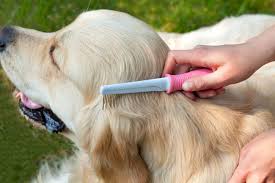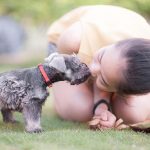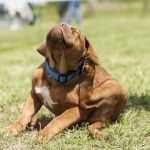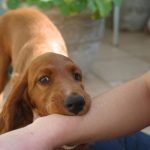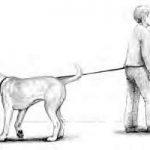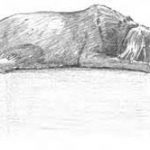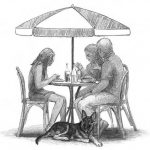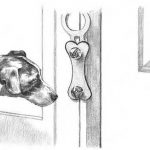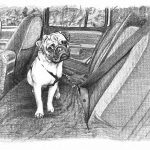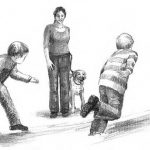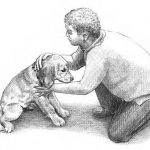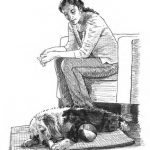- Making grooming easy for you
- Grooming your dog in comfort
- Settling into an enjoyable time for dog and groomer alike
You may not believe it, but I’m here to tell you that grooming can be a fun time for you and your dog. You have plenty of tricks at your disposal, so in this chapter, I explain some of them and show you how you can make grooming fun and enjoyable (or at least tolerable) for you and your dog.
Getting into a Grooming Routine
Everyone complains about being in a rut. But some ruts actually can be good, especially when it comes to grooming. You see, dogs love routine, and when it comes to discovering what to expect from their owners, they’re masters at it. That should tell you right away that today you need to start a grooming routine. Every day at the same time, plan to do a grooming task, such as brushing out your dog’s coat, brushing his teeth, clipping his nails — whatever needs to be done.
Your grooming tasks don’t have to be major productions, like a full brush out, unless, of course, that’s what’s scheduled in your routine. Maybe you only need to clean your dog’s ears or brush his teeth. Whatever the case, if you establish a daily grooming routine, your dog will come to expect something every day at that time, and if you make those sessions fun (see the suggestions later in this chapter), your dog actually will enjoy them, too.
Tip
Pick up a white-board calendar and mark the grooming task you’re going to do each day. That’s right, schedule those tasks, so you know exactly what you’ll be doing and when. Then just do it. Here’s a sample week from my grooming calendar that you can use as a model:
- Monday — Brush out Mishka
- Tuesday — Brush Mishka’s teeth
- Wednesday — Clean Mishka’s ears
- Thursday — Brush out Mishka
- Friday — Clip Mishka’s toenails
- Saturday — Brush Mishka’s teeth
- Sunday — Choose a task that needs to be performed
Depending on whether you have a hairless dog or one who needs to be clipped or stripped, your schedule is likely to be different than my sample calendar. If, for example, you have a corded breed (or a breed with doggie dreadlocks such as the Komondor or Puli), one of your daily tasks will be separating the cords rather than brushing. Similarly, if you have a dog who is blowing coat, or shedding, every day may be a brush-out day.
Remember
Be sure to keep a log of your grooming activities (a diary) every day, so you always know not only what you did that day, but also how your dog behaved and how much work you were able to do. Chapter What Good Grooming Is All About provides a sample diary to get you started.
Starting Out Small and Building Up
Rome wasn’t built in a day, or so the saying goes. Most dogs (and owners) are resistant to grooming, because it takes so darn long. Instead of putting you and your dog through a marathon grooming session, try starting out small.
Maybe your dog hates having his toenails trimmed. Try this: Trim toenails on only one paw today and maybe brush your dog a bit, and then tomorrow, do the next paw and brush him a bit more. As your dog becomes more tolerant of grooming, you can try doing two paws or adding more brushing. Otherwise, the longer you take, the more nervous your dog will become and the worse the struggle.
Taking Your Time While Grooming
One reason some dogs hate grooming is the way their owners handle them. Do you just start grabbing your dog and running a brush or comb through his fur, grumbling all the while that you just don’t have time to do this? Think about it. If you rush through grooming, your dog will look at it as a time when you’re hurried and possibly upset. Dogs pick up on your emotions pretty well. If you’re in a hurry to get done, the dog’s going to be in a hurry to get the heck out of there.
Warning!
Here’s another more important reason to take your time while grooming your dog: When you get in a hurry, you make mistakes, and some mistakes can be downright dangerous for your dog — like being in a hurry with clippers or with scissors. Any time you cause pain to your dog (such as clipping a toenail too short and cutting a quick), you solidify his attitude about not wanting to be groomed in whatever way you caused him pain.
Tip
Choose a time to groom your dog when you’re not in a rush — preferably later in the day when you’re done with work or school, a time when you don’t have any real commitments. Choosing a time later in the day also is good because that’s when your dog is a bit tired out and less likely to struggle with you.
Using the Right Equipment
Use the right tools for the job. (Yes, I’m using up all my clichés in this chapter!) Your grooming sessions will go much easier and smoother when you use the right equipment — not the worthless junk that someone gave to you as a hand-me-down. Although you can use any equipment that still is in good condition as long as it works with your particular dog, you should never use any equipment that just won’t get the job done.
For example, you don’t want to use a pin brush or a hound glove on long-coated or double-coated dogs, because they’re not intended for use with dogs that have those kinds of coats.
Oddly enough most owners insist on not getting a grooming table. Yes, the cost of a grooming table can be somewhat daunting — but so is the cost of visits to the doctor or chiropractor when you’ve wrenched your back from bending over too much. Do yourself a favor and get one.
Remember
Having all the right equipment in the world won’t help one iota unless what you’re using is within reach. Make sure your equipment is ready to go and within reach of the grooming area before you start grooming.
Controlling the Situation at All Times
Prior planning prevents poor performance. In the case of grooming, that means you need to be in control of your dog at all times during the grooming session. You don’t want to chase your dog all around the house while trying to brush him or give him a bath.
That means crating your dog when you’re unable to watch him and keeping him still with aids like a tub noose when you’re washing him or a head noose when you’re grooming him on the grooming table.
Restraining a dog for safety’s sakeIf you’re fearful of being bitten during certain procedures, sometimes a quick muzzle, groomer’s muzzle, or veterinarian’s muzzle is the safest thing for you to use with your dog. I don’t necessarily recommend muzzling your dog, but if you have no choice other than being bitten, you may have to use one. Chapter It’s Showtime! Grooming a Dog for the Ring explains how to muzzle your dog. If your dog continues to show aggressive tendencies, have her examined by a veterinarian to determine whether a health issue is at the root of the problem. If not, you can consult a dog behaviorist or trainer to evaluate your dog. You can find behaviorists and trainers who can help you at the Association of Pet Dog Trainers (APDT) at www.apdt.com. |
Warning!
Never leave a dog unattended in a noose at any time. Your dog can be strangled if left alone in one of them.
Sparing Yourself the Agony: Ergonomics
Does your back hurt when you wash or brush your dog? Are your hands aching when you comb? Ergonomics is a fancy word that came into fashion in the 1980s when scientists in the workplace discovered that certain positions while sitting or standing and doing work are less prone to repetitive injury than others. Likewise, those same scientists discovered certain shapes for tools that fit better in your hands and cause less fatigue than others.
Tip
If you suffer from carpal tunnel, thoracic outlet, arthritis, fibromyalgia, back pain, or any other condition that severely affects your hands or back, consider buying tools that are ergonomically designed. Although they may be a bit more expensive, they’re well worth it.
If you suffer from back pain (or do not want to suffer from back pain in the future), consider these items:
– A raised groomer’s tub: Yes, a raised tub can be pretty expensive, but then how expensive is a bad back?
– Grooming steps or ramps: Steps or a ramp not only help get your dog to and from the tub or grooming table, they keep you from having to lift your dog into and onto them.
– Nonslip cushion mat: If you have hard floors, try putting a nonslip cushion mat on the floor where you walk or stand. Doing so helps with leg, hip, and back fatigue.
– A grooming table: Yes, I’ve belabored this point. I’ll stop now, but be sure to see Chapter Training Your Dog for Grooming.
Making Your Dog Comfortable
Do you like going to the dentist? Unless your dentist is one of those who can guarantee a painless visit, the answer is probably, “No.” Why? Well, besides the possibility of having your teeth drilled, chances are you aren’t comfortable going to the dentist. When you groom your dog, he often isn’t comfortable with what you’re doing and probably is thinking, “You’re going to comb around my WHAT?” or “Don’t you dare get near my paws with that clippie thing!” The upshot: Make your dog as comfortable as possible during each grooming session.
Remember
Temperature is important when performing any type of grooming procedure. Being too cold or too warm makes any dog upset. Be sure the temperature is just right for the air in the room and the water in the tub. Although you may find a hot bath relaxing, your pooch won’t; it’s too hot. Pour a tepid bath (just warm to the touch). Dogs don’t like cold showers, either.
So, the trick is to make your dog as comfortable as possible with the procedures and with where he sits and lies.
Tip
To make grooming a pleasant experience, try:
– Picking up some inexpensive rubber-backed rugs (nonskid, made for bathrooms) at a bath store or even the local discount department store. Appearance doesn’t matter because you’re going to lay them on your grooming table and in your dog’s crate. (Okay, maybe it does matter.)
– Giving your dog toys while he waits for you or even while you’re grooming him. Some dogs will even chew on those soft, plush toys while they’re being groomed. The toy helps ease his fears quite a bit.
– Caring for your dog’s needs before, after, and while grooming him. Your dog may be thirsty, hungry, or need to relieve himself. Nothing is worse than waiting for someone to finish working on you when you have to pee.
– Keeping bath temperatures tepid and keeping the room temperatures slightly warmer than usual while bathing your dog. Keep him warm and away from drafts, especially in cooler weather.
– Keeping your dog cool in the summer. Dogs can overheat easily.
Showing Your Dog that Grooming Is Fun
After reading that headline you’re probably thinking, “Yeah, right. How can a dog enjoy grooming?” Well, believe it or not, many dogs do enjoy it. They enjoy the attention they get from their owners and love being fussed over.
Dogs that love grooming aren’t born that way; they’re made. They’ve been brought up being groomed regularly and taught that grooming is a special time with their owners.
Tip
You can try the following to make your grooming more fun:
– Starting your grooming session after a vigorous play session — when your dog is a bit tired.
– Giving your dog plenty of pets and praise and a treat or two while you’re working on him.
– Avoiding anything that may cause pain. It takes only one painful experience to make him change his mind about grooming.
– Giving him plenty of praise and perhaps a special treat or toy when you’re done with grooming your dog.
Procrastination = Grooming Nightmare
Maintaining a well-groomed coat is easier than trying to groom out a tangled mess — any professional groomer will tell you that. Keep your dog’s coat well groomed (make a grooming schedule like the one suggested in the earlier section on “Getting into a Grooming Routine”), and you’ll never have a grooming nightmare. Even if you have a schedule that has you grooming your dog once or twice a week, that’s better than not doing it at all.
If you’ve been procrastinating, the best thing is to have a professional groomer take care of the problem first so your dog has a coat you can maintain.
Don’t Worry, Be Happy: Keeping It Upbeat
Lastly, keep your grooming sessions positive and upbeat. Being angry and grumpy makes for an unhappy dog and only frustrates you. Never groom your dog while angry or frustrated.
If you can’t be upbeat while grooming, skip the grooming session for today and try tomorrow or just do a quick brush over or quick exam. Then give your dog a treat for being so good and curl up on the couch with him with some ice cream and watch your favorite movie. I guarantee doing so will improve your outlook and make for a better grooming session tomorrow.
by Margaret H.Bonham
